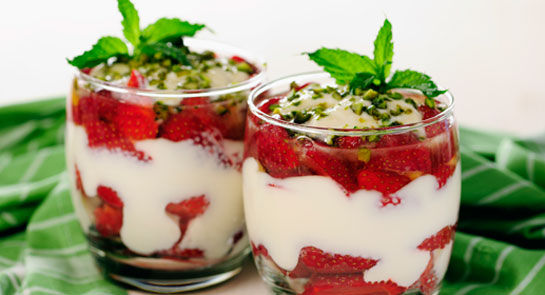
By NATALIE DIGATE MUTH, M.D., M.P.H., R.D.
This summer, Greek yogurt giant Chobani will open its first-ever Greek yogurt frozen yogurt shop in New York City. Meanwhile, the grocery-store demand has exploded as Greek yogurt, once a little-known product sold in specialty stores, has become a widely available household favorite. With sales increasing more than 100 percent every year for the past three years, Greek yogurt is credited with single-handedly boosting the hurting American dairy industry. But is this Greek yogurt craze just another fad, or is there really something to it?
Old-fashioned Greek yogurt is made with goat’s milk while American yogurt, and many of the American-made “Greek-style” products, are made from cow’s milk. (“Greek-style” yogurts may also contain thickening agents like condensed milk or gelatin.) All yogurt starts out the same, with milk and live cultures. In the case of Greek yogurt, the live cultures are the active bacteria S. thermophilus (St) and L. bulgaricus (Lb), which ferment the milk to make its characteristic tangy taste. With Greek yogurt, the milk and culture combo is then strained with a filter to remove the liquid whey part of milk. The straining process also removes some of the lactose sugars, salt and water. What is left is a thicker, creamier product that is higher in protein, but lower in sugar and carbohydrates than American-style yogurt. But to get the same amount of product as the American-style yogurts, you’ve got to use a lot more milk. For the American yogurts, the ratio of milk to yogurt is about 1:1. For the Greek products it can be as high as 4:1. That means it can take up to four gallons of milk to make one gallon of Greek yogurt.
Thick, creamy and a little bit tangy, Greek yogurt appeals to the health-conscious consumer craving a sweet snack that also packs a nutritional punch without an excess of calories. Of course, American yogurt fits the bill as well—both are rich in calcium and low in calories and have loads of probiotics, the healthy bacteria that may help boost immunity and decrease gastrointestinal symptoms like diarrhea and abdominal pain. But with its high-protein content and lower levels of sugar and salt, Greek yogurt may just be a little bit better for you than the American stuff.
At the end of the day, both Greek and American yogurts are nutrient-packed snacks that are excellent additions to any healthful diet.
| The Nutritional Value of Greek and American Yogurts |
(6oz)
|
Chobani Non-fat
Greek Yogurt
(plain)
|
Dannon
Non-fat Yogurt
(plain) |
Calories (kcal)
|
100 |
80
|
|
Carbohydrates (g)
Sugar (g)
Fiber (g) |
7
7
0
|
12
12
0
|
Protein (g)
|
18 |
9
|
| Calcium |
20 |
30
|
Sodium (mg)
|
80 |
120
|
Vitamin A
|
0 |
0 |
Vitamin C
|
0 |
4
|
Iron
|
0 |
0
|
Price
|
$1.59 |
$1.29 |
______________________________________________________________________
 Natalie Digate Muth, M.D., M.P.H., R.D., is a pediatrics resident at UCLA Medical Center, a registered dietitian and a spokesperson for the American Council on Exercise (ACE). She holds fitness certifications from ACE, the American College of Sports Medicine and the National Strength and Conditioning Association.
Natalie Digate Muth, M.D., M.P.H., R.D., is a pediatrics resident at UCLA Medical Center, a registered dietitian and a spokesperson for the American Council on Exercise (ACE). She holds fitness certifications from ACE, the American College of Sports Medicine and the National Strength and Conditioning Association.